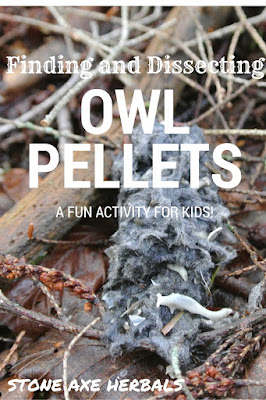Finding and Dissecting Owl Pellets
Almost everyone has dissected at least one owl pellet in their elementary school science class, now it may be time to share this fun activity with your own children. Dissecting owl pellets is a great way for kids to learn about how ecosystems work, the food chain, and wildlife anatomy. You can purchase owl pellets cheaply and easily, but it is actually pretty easy to find them yourself. Plus, going out and finding one (or multiple) makes it all that much more fun and educational!
Where to Look:
While each owl species has its own preferences as far as food and location, all tree nesting owls are pretty much looking for the same thing. Barred owls may be looking for frogs and mice near vernal pools or ponds, while great horned owls may be looking for rodents and other small mammals, such as rabbits or even skunks where field and forests meet. Barn owls are probably looking for mice and rats in open farm fields. All of these owls are looking for a place to hunt where game is readily available and they can see a long distance without anything obstructing their view.
To find a place like this, look for places that might be good habitat for the prey animals. Vernal pools, brush piles in fields, grasslands, and places where there is grain on the ground are all good places to start as these places provide food and shelter for rodents and small mammals and amphibians. Keep in mind what owls are in your local area and what they might be eating.Then, look for the highest place with the best view, a place where an owl might want to sit and watch. Most often, these are large, dead trees in the middle of or on edges of fields. These trees, sometimes called wolf trees, are ideal places for owls to hunt from. Owls may also hunt from barns or other buildings as well. Basically, they want the highest vantage point around, and in some places, as with snowy owls in the arctic, this might simply be a large rock.
This pellet was found at the base of a large tree next to a vernal pool.
Once you find a place where you think an owl might be, look for signs of it. Pellets can be found on the ground along with feathers. Feathers can also be found caught on branches if it is a tree so don't forget to look up. Look for feces on plants beneath. Even if you don't find a pellet, but you find other signs of owls, keep coming back regularly to look. Owls produce pellets often as they cannot digest bones and hair and have to eat many small rodents to stay alive. Although owl pellets are just dry balls of bones and hair, it is suggested that if you do find one, you should wear gloves to pick them up. Put the pellet in a hard container so it doesn't get destroyed on your way home.
Now that you have your pellet(s), it's time to start dissecting! If you can't find any, don't worry, you can still purchase them online.
You will need:
-Gloves
-Tweezers or toothpicks
Optional:
- Mammal ID book that includes rodents
- Owl ID book (I highly recommend The Complete Book of North American Owls
- Magnifying Glass or hand lens
- Owl pellet bone ID chart
First, with gloves on, break up your pellet into smaller chunks careful not to break any of the tiny bones in it. You can start methodically picking the chunks apart, pulling out individual bones with the tweezers, toothpicks, or your fingers. Sort the bones into piles if you like.
You can look at a bone ID chart to determine what animals this owl has been eating. You can find one here: http://www.biologycorner.com/resources/Owl_Pellet_Bone_Chart_grid.pdf
or simply google image search "owl pellet bone ID chart" and you will find many free ones.
From here, you can use a Mammal ID book to determine the species (remember that there may be more than one). Peterson Field Guide to Mammals of North America: Fourth Edition (Peterson Field Guides)
Once you determine what the owl has been eating and where it has been hanging out, you can often determine which species of owl it was by looking at an owl ID book.
That's all there is to it! Have fun and happy owl pellet hunting!
Here are some books that I highly recommend for learning more about owls:
Disclaimer: This blog is just my own opinion, nothing more. While I try my hardest, everything may not be completely accurate or complete. Sorry, I'm only human, so do not hold me accountable for anything you do to harm yourself or the world around you. I do make money from this blog (seriously not very much at all guys). If you click on any of the links in my blog I may make money from it. I'm not sponsored by any of these people I just honestly love these products and want to give you the resources to find them. I am not a medical practitioner; consult a health professional before using any herbal remedies. I am not claiming to diagnose, treat, prevent, or cure any ailment.



